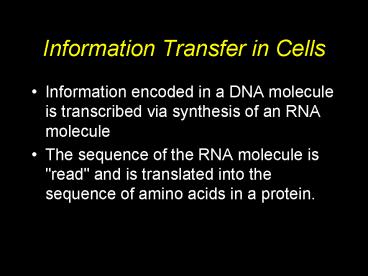Information Transfer in Cells PowerPoint PPT Presentation
Title: Information Transfer in Cells
1
Information Transfer in Cells
- Information encoded in a DNA molecule is
transcribed via synthesis of an RNA molecule - The sequence of the RNA molecule is "read" and is
translated into the sequence of amino acids in a
protein.
2
(No Transcript)
3
Review of DNA Structure
- What is a nucleoside?
- What is a nucleotide?
- What forces hold DNA together as a helix?
- Why are there two kinds of grooves in a B DNA
helix? - What are the differences between A, B and Z forms
of DNA
4
DNA (deoxyribonucleic acid)
Building blocks deoxyribonucleotides
5
Ribose
5
1
4
2
3
Ribose - a pentose sugar - a furanose ring - in
RNA - in nucleotides for energy metabolism (ATP)
2 deoxyribose - a pentose sugar - a furanose
ring - in DNA
6
(11.2 Pentoses of Nucleotides)
- D-ribose (in RNA)
- 2-deoxy-D-ribose (in DNA)
- The difference - 2'-OH vs 2'-H
- This difference affects secondary structure and
stability
7
(No Transcript)
8
11.1 Nitrogenous Bases
- Pyrimidines
- Cytosine (DNA, RNA)
- Uracil (RNA)
- Thymine (DNA)
- Purines
- Adenine (DNA, RNA)
- Guanine (DNA, RNA)
9
(No Transcript)
10
(No Transcript)
11
(No Transcript)
12
Naturally occurring purine derivatives
13
Properties of Pyrimidines and Purines
- Keto-enol tautomerism
- Strong absorbance of UV light
14
Guanine
Guanine
15
Nucleoside
A purine/pyrimidine deoxyribose or ribose
Cytosine
4
5
3
6
2
1
Cytidine
16
11.3 Nucleosides
- Linkage of a base to a sugar
- Base is linked via a glycosidic bond
- Named by adding -idine to the root name of a
pyrimidine or -osine to the root name of a purine
- Sugars make nucleosides more water-soluble than
free bases
17
(No Transcript)
18
(No Transcript)
19
11.4 Nucleotides
- Nucleoside phosphates
- Know the nomenclature
- "Nucleotide phosphate" is redundant!
20
(No Transcript)
21
(No Transcript)
22
Deoxyribonucleic acid
DNA is a nucleotide polymer linked by a 3 to 5
phosphodiester bond
5 phosphate
3 hydroxyl
23
Single-stranded DNA Has polarity Has a
hydrophilic side Has a hydrophobic side
24
RNA versus DNA - Stability issues
25
Double-stranded DNA
1) Pair of DNA chains in an antiparallel
arrangement
2) Sugar-P backbone outside, aromatic rings
(bases) inside
3) Bases pair specifically by H-bonding
A pairs with T G pairs with C A T and G
C purines pyrimidines
26
(No Transcript)
27
The canonical base pairs
- The canonical AT and GC base pairs have nearly
identical overall dimensions - A and T share two H-bonds
- G and C share three H-bonds
- GC-rich regions of DNA are more stable
- Polar atoms in the sugar-phosphate backbone also
form H-bonds
28
(No Transcript)
29
Why a helix? Why not a ladder?
- A side view of base pairs shows they are
perpendicular to the helix axis - The heterocyclic bases have flat surfaces which
are hydrophobic - To exclude water from between the rings, we
should bring the bases closer together - One way to model them closer together is to
twist the ladder into a helix
30
Right-handed twist 10 base pairs per turn B form
DNA helix
31
Summary What holds DNA together?
- Sugar-phosphate backbone outside
- (1) minimizes electrostatic repulsion,
- (2) interacts with water
- Bases inside
- (3) hydrogen-bonded
- (4) plus base stacking by hydrophobic interactions
32
(No Transcript)
33
(No Transcript)
34
Major and minor grooves
- The "tops" of the bases (as we draw them) line
the "floor" of the major groove - The major groove is large enough to accommodate
an alpha helix from a protein - Regulatory proteins (transcription factors) can
recognize the pattern of bases and H-bonding
possibilities in the major groove
35
Comparison of A, B, Z DNA
- A right-handed, short and broad, pitch is 2.3 A,
11 bp per turn - B right-handed, longer, thinner, pitch is 3.4
A, 10 bp per turn - Z left-handed, longest, thinnest, pitch is 3.8
A, 12 bp per turn
36
(No Transcript)
37
(No Transcript)
38
Picture of E. coli DNA outside of the cell
39
DNA Packaging
- Human DNA total length is 2 meters
- Is packaged into a nucleus that is 5 microns in
diameter - This represents a compression of more than
100,000 fold - It is made possible by wrapping the DNA around
protein spools called nucleosomes and then
packing these into helical filaments
40
(No Transcript)
41
(No Transcript)
42
We reviewed Chapter 11, Sections 11.1, 11.2,
11.3, 11.4, 11.5 and the DNA parts of
11.6 Chapter 12, Sections 12.2, 12.5

